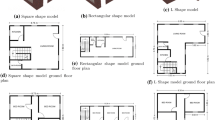Abstract
The building energy simulation (BES) models are extensively used to predict heat loads in buildings. Despite its significance, however, the geometric cuboid effect on the convective heat transfer coefficient (CHTC) is yet to be considered in the BES models. In this paper, effects of height, width, length, and angle of attack of a cuboid and also the effect of air speed on the CHTC were experimentally studied to highlight unreliability of the models ignoring the cuboid geometry. For this purpose, a total of 16 experiments were designed using the Taguchi’s design of experiments (DOE), where the considered factors were varied at 4 levels. The percent contribution of each factor to the output variable was determined by the analysis of variance (ANOVA), indicating the significance of all geometric factors when it came to the CHTC. The linear regression analysis was further performed to define a linear correlation for predicting the overall CHTC under different geometric conditions. Accordingly, two nonlinear correlations were developed for the cuboid geometry and one correlation was obtained for building applications, by which one could predict average Nusselt number (Nu).










Similar content being viewed by others
Abbreviations
- A:
-
Surface area (m2)
- a:
-
Cuboid width (m)
- α :
-
Angle of attack (°)
- \(\overline{{\alpha_{I} }}\) :
-
Mean effect of α at level Ι
- b:
-
Cuboid height (m)
- β :
-
Unknown parameters
- C:
-
Constant numbers
- c:
-
Cuboid length (m)
- CF:
-
Correction factor
- ε :
-
Error
- G:
-
A function of geometric factors
- \({\overline{\text{h}}}\) :
-
Convective heat transfer coefficient (CHTC) (W/m2K)
- K:
-
Conductivity (W/m.K)
- \(\overline{Nu}\) :
-
Nusselt number
- n1, n2 :
-
Constant numbers
- p:
-
Percent contribution (%)
- \(\dot{q}\) :
-
Heat transfer rate (W)
- Q:
-
Flow (lit/s)
- ρ :
-
Density (kg/m3)
- R:
-
Sum of total experimental results (CHTC)
- r:
-
Correlation coefficient
- Reb :
-
Reynolds number based on dimension b
- Rec :
-
Reynolds number based on dimension c
- S (ss):
-
Total variance or the sum of squares
- T:
-
Temperature (K)
- \(\Delta T\) :
-
Temperature difference (K)
- ti:
-
Turbulence intensity (%)
- V:
-
Air speed (m/s
- σ :
-
Stefan-Boltzmann constant (5.67 × 10–8(W/m2K4))
- λ :
-
Emissivity
- w:
-
Wall or surface
- ∞:
-
Free airstream
- Ι, ΙΙ, ΙΙΙ, ΙV:
-
Levels 1 to 4, respectively
- in, Out:
-
Inlet, outlet
- 1, 2, …, 16:
-
Experiment number
- op:
-
Optimum conditions
- max, Min:
-
Maximum, minimum
References
M. Mirsadeghi, D. Cóstola, B. Blocken, J.L.M. Hensen, Review of external convective heat transfer coefficient models in building energy simulation programs: implementation and uncertainty. Appl. Therm. Eng. 56, 134–151 (2013)
T. Defraeye, B. Blocken, J. Carmeliet, Convective heat transfer coefficients for exterior building surfaces: existing correlations and CFD modeling. Energy Convers. Manag. 52, 512–522 (2011)
D.B. Crawley, J.W. Hand, M. Kummert, B.T. Griffith, Contrasting the capabilities of building energy performance simulation programs. Build. Environ. 43, 661–673 (2008)
J.A. Palyvos, A survey of wind convection coefficient correlations for building envelope energy systems’ modeling. Appl. Therm. Eng. 28, 801–808 (2008)
T. Igarashi, Fluid flow and heat transfer around rectangular cylinders (the case of a width/height ratio-of a section of 0.33 - 1.5). Int. J. Heat Mass Transfer. 30(5), 893–901 (1987)
T. Igarashi, Y. Mayumi, Fluid flow and heat transfer around a rectangular cylinder with small inclined angle (the case of a width /height ratio of a section of 5). Int. J. Heat and fluid flow. 22, 279–286 (2001)
J. Olsen, B.W. Webb, M. Queiroz, Local three dimensional heat transfer from a heated cube, presented at the ASME winter annual meeting, San Francisco, (1989)
V. Natarajan, M.K. Chyu, Local heat/mass transfer distributions on the surface of a wall-mounted cube. J. Heat Transfer 113, 851 (1991)
V. Natarajan, M.K. Chyu, Effect of flow angle-of-attack on the local heat/mass transfer from a wall-mounted cube. Transactions ASME 116, 552 (1994)
E.R. Meinders, K. Hanjalic, R.J. Martinuzzi, Experimental study of the local convection heat transfer from a wall-mounted cube in turbulent channel flow. Transactions ASME 121, 564 (1999)
H. Nakamura, T. Igarashi, T. Tsutsui, Local heat transfer around a wall mounted cube in a turbulent boundary layer. Int. J. Heat fluid flow 44, 3385–3395 (2001)
H. Nakamura, T. Igarashi, T. Tsutsui, Local heat transfer around a wall mounted cube at 45° to flow in a turbulent boundary layer. Int. J. Heat Fluid Flow 24, 807–815 (2003)
R. N. Meroney, Studying the convective heat transfer from a building model with infrared camera techniques, ASME Winter Annual Meeting, December 10–15, San Francisco, California, May, 28 p, ASME Paper 78-WA/HT-58, (1978)
H. Montazeri, B. Blocken, D. Derome, J. Carmeliet, J.L.M. Hensen, CFD analysis of forced convective heat transfer coefficients at windward building facades: influence of building geometry. J. Wind Eng. Indus. Aerodyn. 146, 102–116 (2015)
H. Montazeri, B. Blocken, New generalized expressions for forced convective heat transfer coefficients at building facades and roofs. Build. Environ. 17, 30172–30175 (2017)
I. Kotcioglu, K.M. Nasiri, A. Cansiz, Experimental investigation for optimization of design parameters in a rectangular duct with plate-fins heat exchanger by Taguchi method. Appl. Therm. Eng. 50, 604–613 (2013)
I. Kotcioglu, K.M. Nasiri, A. Cansiz, Heat transfer analysis of a rectangular channel having tubular router in different winglet configurations with Taguchi method. Appl. Therm. Eng. 132, 637–650 (2018)
A.H. Bademlioglu, A.S. Canbolat, N. Yamankaradeniz, O. Kaynakli, Investigation of parameters affecting organic rankine cycle efficiency by using Taguchi and ANOVA methods. Appl. Therm. Eng. 145, 221–228 (2018)
X. Lu, G. Zhang, Y. Chen, Q. Wang, M. Zeng, Effect of geometric parameters on flow and heat transfer performances in multi-stream spiral-wound heat exchangers. Appl. Therm. Eng. 50, 1104–1116 (2015)
K. Bilen, S. Yapici, C. Celik, A Taguchi approach for investigation of heat transfer from a surface equipped with rectangular blocks. Energy Convers. Manag. 42, 951–961 (2001)
D.C. Montgomery, Design and analysis of experiments, 5th edn. (John Wiley and Sons, 2001)
G. Taguchi, System of Experimental Design (Kraus International Publications, New York, 1987)
K. Ranjit Roy, A Primer on the Taguchi Method (Society of Manufacturing Engineers, Michigan, 1990)
K. Ranjit Roy, Design of Experiments Using the Taguchi Approach: 16 Steps to Product and Process Improvement (Wiley, New York, 2001)
F.P. Incropera, D.P. Dewitt, Th.L Bergman, A.S. Lavine, Introduction to Heat Transfer, 5th edn. (John Wiley & Sons, 2007)
Minitab 17 Statistical Software (Minitab, Inc., State College, PA, 2016). www.minitab.com
W.Y. Fowlkes, C.M. Creveling, Engineering Methods for Robust Product Design (Addison-Wesley, USA, 1995)
D.M. Bates, D.G. Watts, Nonlinear Regression Analysis and Its Applications (Wiley, Hoboken, 1988)
Author information
Authors and Affiliations
Corresponding author
Rights and permissions
About this article
Cite this article
Babakhani, J., Veysi, F. Experimental study of geometric cuboid effect on convective heat transfer. Eur. Phys. J. Plus 137, 215 (2022). https://doi.org/10.1140/epjp/s13360-022-02430-2
Received:
Accepted:
Published:
DOI: https://doi.org/10.1140/epjp/s13360-022-02430-2




